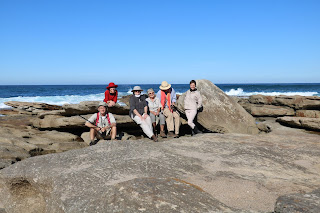The Iron Crown
The wind came up, gusty, at our meeting place, but it paused
whilst we botanized on the Western Heights, and then came up again when we
left, making it seem as if we had been lost in a protected capsule.
As we navigated our way in our vehicles towards the Iron
Crown, the road was blocked – camouflaged by fallen Eucalyptus trunks, which
lay like cattle grids across the road.
Eager arms cut and dragged trees and branches out of road before
finally, the old, rickety farm gate opened on utopia – the Umtamvuma reserve.
Long grass waved in the wind and the vehicles kicked up clouds of dust from the
bone-dry road. Where the earth ends in sheer drops, we stopped.
Our feet led us to a section of the reserve where there had
been a controlled burn. Against the black charred canvas, brightly coloured
Gerbera natalensis and Gazania krebsiana stood out. In sharp contrast, the Boophane disticha
stood out like miniature ant mounds, black in the shiny armour that had survived
the fire, all waiting to burst forth in a display of pink fireworks.
 |
Gerbera natalensis |
 |
Gazania krebsiana |
 |
Boophone disticha |
 |
Helichrysum lepidissimum |
With our gaze all the while fixed slightly ahead of our feet,
our heads shot up at the sound of sudden excitement ahead. Anne and Tracy had come upon a Black Mamba
sunning itself on a rock. Like two
sentinel meerkats, they kept us back, while we peered at the crevice where the
beautiful serpent had disappeared – before turning back momentarily to see who
had dared to invade its territory. An
Iguana lay nearby watching us, ignorant
of the nearby danger.
 |
Dik-bek Rock near the Black Mamba Cave |
All around, the Protea had dropped their russet seed, and
amid the Gerbera natalensis, their woolly stalks protecting them from the
elements, Othonna natalensis were beginning to bud and bloom.
 |
Othonna natalensis -Natal Geelbossie |
 |
Gerbera natalensis |
 |
Protea caffra |
 |
Seeds from the Protea caffra |
Once again I looked up when our sentinel gave a warning
cry. A swarm of bees rose like a black
cloud and made a bee-line for us.
Debbie, who is allergic to them, disappeared into the edges of the
gorge, while Mark, Alf and Anne rolled up like pangolins and didn’t move until
the swarm had passed.
 |
Mark |
 |
A swarm of bees. |
 |
Crouching down as a swarm of bees fly over Mark, Alf and Anne. |
At the edge of a cliff where we could walk no further, we sat
– like Pooh with a jar of honey – to
have our lunch. The peace and the beauty was indescribable. Slowly, an eagle
rose up on the thermals from the river bed, spiral after spiral after spiral,
until it finally took flight like a kite into the sky.
 |
Lunch with a view. |
 |
Dorothy living on the edge. |
We strolled back to our vehicles,
content and grateful. Another special day, and we had survived Covid-19, a
Black Mamba and a swarm of bees.
 |
Erica cerinthoides |
 |
Osteospermum imbricatum |
 |
Gerrardina foliosa |
 |
Polystachya pubescens |
 |
Tridactyle bicaudata |
 |
King Protea - Protea cynaroides |
 |
Front: Gail Bowers-Winters and Tracey Taylor Back: Mark Gettliffe, Debbie King, Dorothy Mcintyre, Alf Hayter and Anne Skelton. |














































